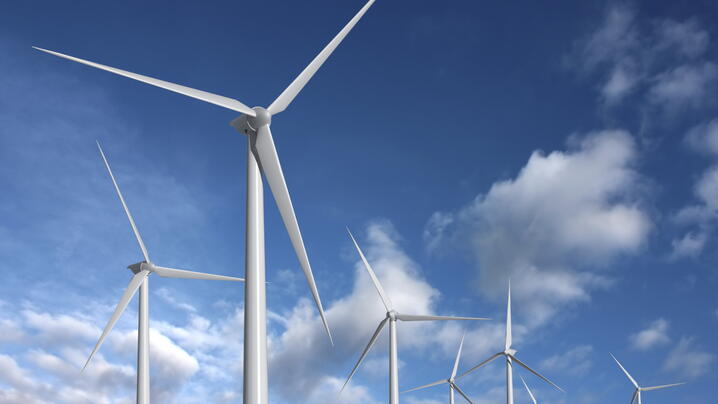
By Hannah Hunt, deputy director, electricity policy and demand, American Wind Energy Association (AWEA)
To get started, here are five questions that can help determine how a community might meet its clean energy commitment.
1. What’s your community’s goal?
While hundreds of local governments have made commitments to use more clean energy or reduce their carbon footprints, not every commitment is the same. So first, you need to figure out what your local govenrment is trying to accomplish.
Some places like St. Louis are going 100 percent renewable energy to meet all electricity demands in the city, including from businesses and residents; others like Chicago are going 100 percent renewable energy for government buildings specifically. Knowing what is your community’s goal will help determine how much clean energy you’ll need to procure – and how difficult it might be to do it.
2. Does your community own its electric utility?
A municipal-owned utility (MOU) can purchase electricity on the community’s behalf and deliver it to customers.
One city with an MOU that’s now 100 percent clean energy is Greensburg, Kansas. After a tornado destroyed much of the city in 2007, the community decided to rebuild sustainably, including getting all of its electricity from renewable sources.
Greensburg City Administrator Kyler Ludwig explains: “In 2009, Greensburg entered an agreement with Greensburg Wind Farm LLC to secure renewable energy credits for all energy used within the city. Greensburg’s commitment to 100 percent renewable energy goes beyond the environmental impacts. I believe that moving toward renewable energy has strengthened our community’s identity.”
3. Does your state have retail electric choice?
Sixteen states and the District of Columbia allow nonutility entities with a large enough electricity demand (including city governments, corporations, or universities) to purchase electricity directly from a generation source like a wind farm, for example. A city in one of these deregulated states can purchase electricity for its government operations without having to get it through the local utility that serves its area.
Several cities have taken advantage of this opportunity. The Washington, D.C. government, for example, signed a long-term contract to supply roughly 35 percent of its government buildings’ electricity demand with wind power.
Mark Chambers, sustainability and energy management director, D.C. Department of General Services, explained at the time: “Directly sourcing renewable power costs 30 percent less than fossil fuel-based sources, reduces greenhouse gas emissions by 100,000 tons, and protects our city from volatile energy price increases. Put another way, during its 20-year span, this deal removes the same amount of carbon from our atmosphere as planting 44 million trees or removing 18,000 cars from the road every year.”
4. Can your community aggregate residents’ demand for clean energy?
In certain deregulated states, local governments can aggregate the individual demand for clean electricity from homeowners and businesses and use that collective buying power to sign a contract for clean energy with an alternative energy supplier that is not their local utility. This is achieved through community choice aggregation (CCA) programs.
New Rochelle, New York, joined together with 19 other towns in New York to create Westchester Power, a CCA program that provides 100 percent clean energy for residents and businesses in downstate New York.
Chuck Strome, city administrator, New Rochelle, says, “The city of New Rochelle has been involved with community choice aggregation for two years, and has seen tremendous benefits. The program as a whole has resulted in customer savings of more than $2 million and avoided 2 million tons of carbon dioxide emissions. New Rochelle residents enjoy a proportionate share of those savings and carbon dioxide emission reductions. Residents of New Rochelle have enthusiastically embraced the reductions on their utility bills and the use of cleaner energy supplies.”
5. Does the utility that serves your community have a green tariff program?
A green tariff allows a city or other large buyer to procure renewable energy through its utility, paying a special rate for the clean energy supply. Thirteen green tariffs in 10 states have been proposed or approved to date, and several more are in the pipeline.
Snoqualmie, Washington, is one of the first cities in the country to take advantage of a green tariff, which was offered by Puget Sound Energy. Snoqualmie will join other Washington towns and well-known brands like Target and Starbucks in “subscribing” to a portion of the electricity generated by a new wind project under development in Washington state.
Bob Larson, city administrator, Snoqualmie, says, “We are very excited at the opportunity to power all city facilities with green power. Citizens want clean energy. Responding to that demand, while securing stable energy costs that could save us funds long-term, was a win-win. We applaud PSE’s efforts to mature a collaborative new wind project, both reducing climate emissions and developing an asset that contributes to regionally low-energy rates.”
If you’d like to learn more on how local governments can purchase clean energy, visit www.awea.org/municipal-wind.
AWEA is an ICMA Strategic Partner that is a national trade association representing the interests of America’s wind energy industry.
Related Content
200 Cities and Counties Now “Open for Solar Business.” This 2018 article includes information on some local government programs that allow for greater adoption of solar energy.
Energy Efficiency Checklist for Local Governments. In a 2018 blog post, ICMA details a checklist for local governments on energy efficiency that includes helpful information on assessing a community's local government's energy data, along with other tips.
Does Your Local Government Need to Start Thinking About Smart Energy and Water Technologies? Another 2018 blog post that includes four communities that are highlighted for using smart city applications in the areas of energy, water, and wastewater operations.
New, Reduced Membership Dues
A new, reduced dues rate is available for CAOs/ACAOs, along with additional discounts for those in smaller communities, has been implemented. Learn more and be sure to join or renew today!
